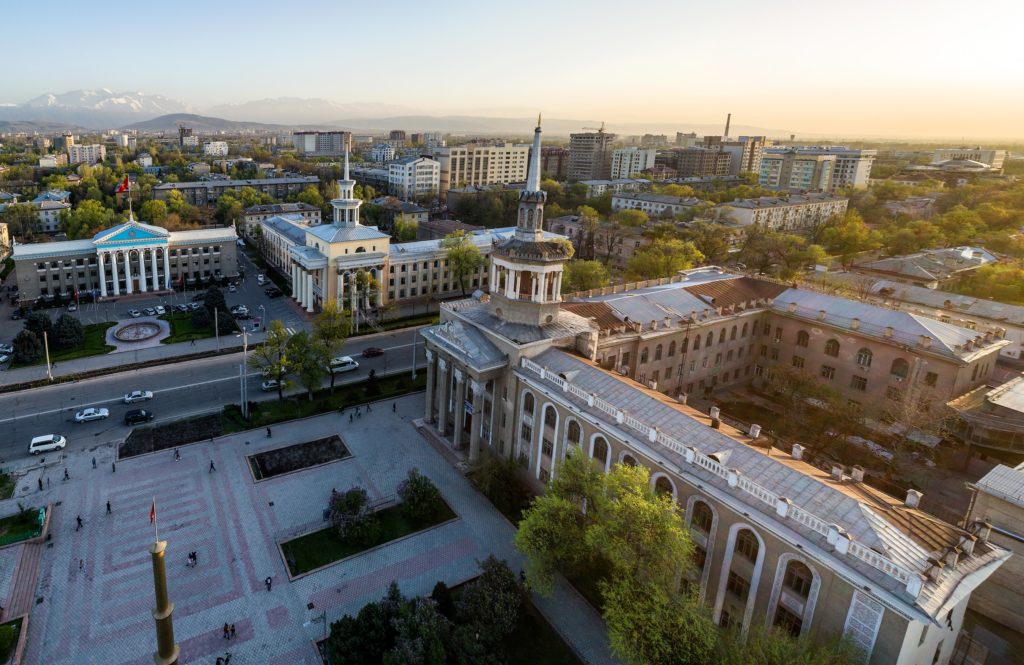Kyrgyzstan is a small, distinctive, and amazing mountainous country. It is surrounded by the powerful Tien Shan and Pamir-Alai mountain ranges. Tien Shan lies in the north-eastern part, and Pamir-Alai in the south-western part. The highest point of Kyrgyzstan is the monumental and harsh Pobeda Peak – 7 439 m. There are many other significant-high peaks in the country, which attract climbers from all over the world.
Kyrgyzstan has no outlet to the sea, and its main territory is occupied by mountains, and this is more than three quarters. Geographically, Kyrgyzstan is conditionally divided by mountain ranges and passes into the north (Talas, Chui, Issyk-Kul, and Naryn regions) and the south (Batken, Osh, and Jalal-Abad regions). The climate in the country is sharply continental, due to the mountain system. Rainfall varies greatly depending on location. In the mountains, it can drop up to 2000 mm per year, and on the western shore of Issyk-Kul, they are less than 100 mm per year. In general, Kyrgyzstan is a sunny country, only in some local valleys cloudiness prevails.
Glaciers located in the mountainous regions of Kyrgyzstan are of great importance for the whole of Central Asia. Glaciers accumulate a huge supply of fresh water and feed many rivers. According to rough estimates, there are about 8,000 glaciers in the republic, which occupy 4% (about 8,000 km2) of the territory of Kyrgyzstan, and together with eternal snows, they occupy 40.5% of the country’s territory (about 81,000 km2). This is much larger than the area of the glaciers of the Caucasus and the Alps combined. Glaciers store about 650 km3 of ice. There are many rivers and lakes in the country, rich flora, and fauna.

How many days to allocate for a trip to Kyrgyzstan?
The simple answer to this question is “as much as you can” because there are so many opportunities for active recreation in Kyrgyzstan that it is simply impossible to squeeze it all into a few days. Besides, the peculiarities of the area in the region and the inaccessibility of some of the attractions can stretch your trip for a long time. We recommend that you allocate as much time as possible to travel to Kyrgyzstan. You may also find the following information useful:
Bishkek, the capital of Kyrgyzstan, is more than a place of arrival in the country. In Bishkek, there are large shopping centers, restaurants, theaters, museums … The first acquaintance with Kyrgyzstan will be noisy and fun!
How many days does it take? 2-3 days if you want to take a day trip to nearby attractions
Main attractions: Ala-Too Square, Oak Park, Osh Bazaar
How to get off the beaten path: Take a day trip to Ala-Archa Gorge or visit Burana Tower in ancient Balasagun.
Osh is the capital of southern Kyrgyzstan, heavily influenced by Uzbek culture.
How many days does it take? 1-2 days
Main attractions: Mount Sulaiman-Too, Lenin monument (the largest in Central Asia), Navoi Park
How to get off the beaten path: Head to Kyrgyz-Ata National Park or explore the historic town of Uzgen and its famous market.
Jalal-Abad is the third most populous city in the country (after Bishkek and Osh), in the past, it was the largest point on the Great Silk Road in the region. It is considered a sacred city.
How many days does it take? 1 day
Main attractions: Lenin Street, mineral springs in the Jalal-Abad sanatorium, Arslanbob walnut forest
How to get off the beaten path: book a stay at a family guesthouse in the neighboring village of Kara-Sulu or spend the night in Sary-Chelek National Park.
Karakol is a city near Lake Issyk-Kul, the 4th largest city in the country and a starting point for mountain hikes.
How many days does it take? 1-2 days
Main attractions: Orthodox Church of the Holy Trinity, Dungan Mosque, Przewalski Memorial Museum
How to get off the beaten path: Dine with a minority Uyghur or Dungan family, or learn how to bake local bread with one of the hospitable families in nearby Jergalan.
Cholpon-Ata is a resort and historical town on the shores of Lake Issyk-Kul.
How many days does it take? 2 days
Main attractions: Petroglyphs of Cholpon-Ata, Rukh Ordo Cultural Center, Issyk-Kul State Historical and Cultural Museum
How to get off the beaten track: overnight in a yurt camp in the mountains or parasailing over Issyk-Kul.
Naryn is the regional capital of the most mountainous region of Kyrgyzstan.
How many days does it take? 2 days if you want to explore the area
Main attractions: Koshoy-Korgon fortress, At-Bashi village, rafting on the Naryn river
How to get off the beaten path: Head to the Torugart Pass and stop at the Tash Rabat Caravanserai along the way.
Kochkor is a small and very cozy mountain town, where all conditions are created for tourists traveling around the region.
How many days does it take? 1-1.5 days
Main attractions: Altyn-Kul city, Son-Kul lake, Kochkor museum of local lore
How to get off the beaten path: Explore the Chong Tuz Salt Caves or spend the night in a yurt on Kol Ukok Lake.
Talas is one of the westernmost cities of Kyrgyzstan; Talas borders with Kazakhstan and is rarely visited by tourists. However, there is a lot to see here.
How many days does it take? 1 day
Main attractions: Manas Ordo, Kirov reservoir, Tuyuk-Tor Petroglyphs
How to get off the beaten path: Explore the Besh Tash National Park or the Herzen Museum in the nearby village of Ak Dobo.
The cost of rest in Kyrgyzstan
Going on vacation to Kyrgyzstan, each tourist counts on a certain budget. Even though the country offers a high-level resort vacation, here you can have a good time and find entertainment for both wealthy and budget tourists.
The cost of rest in Kyrgyzstan depends on the selected region, preferred entertainment, as well as on the time spent in the country.
In banks, exchange offices, and hotels, you can exchange US dollars, euros, Russian rubles, British pounds, and Chinese yuan for Kyrgyz soms. Exchange offices and banks do not accept banknotes if they are old, worn out, torn, crumpled, or if they are handwritten. Besides, it is advisable to exchange currency in the capital, since the rate is slightly lower in the province. Credit cards are accepted in the capital’s banks and some large hotels in Bishkek. It is almost impossible to withdraw funds from the card in the province. The same applies to traveler’s checks. Thus, it is advisable to exchange funds with insufficient volume before traveling to Kyrgyzstan.
